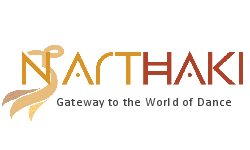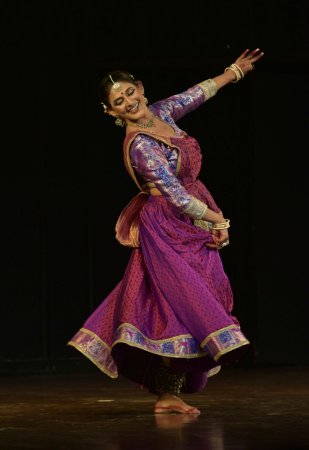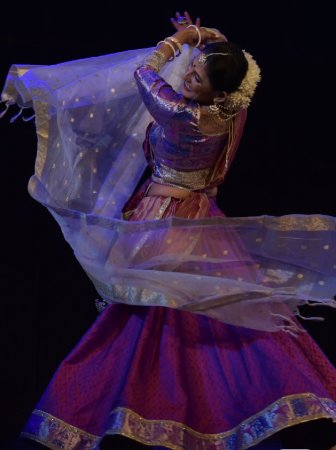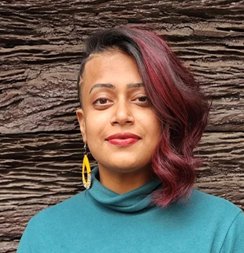
|   |

|   |
Dancing memory, tasting history: Dr. Navina Jafa's Kathak solo 'Udaan - The Flight' - Sumedha Bhattacharyya e-mail: duetwithcamera@gmail.com Photos: Jaison Thomas May 22, 2025 On the evening of April 28, 2025, the Stein Auditorium became more than a stage - it became a pilgrimage of memory. In collaboration with the Artists Association of India and Habitat Centre, Udaan - The Flight, Dr. Navina Jafa did not just perform Kathak; she invoked it as a durational archive of syncretic history of dance and music relationship within the repertoire of Kathak. Against a backdrop of thumri and resonant padhant, her solo became a cultural reckoning with Rampur's courtly past, gently resisting spectacle in favour of layered storytelling in the present. What does it mean to remember a place and evoke it through the body? The performance opened with a poignant Virah (separation), choreographed to a Thumri in raga Khamaj. Against the imagined monsoon sky, Jafa's Nayika longed for Krishna - not with loud anguish, but with a still, aching interiority. This was not merely a narrative of love but a choreography of memory: of mythic time, emotional cycles, and the monsoon as a recurring seasonal and psychic rhythm. In her approach to Kathak, slowness became an inquiry. Each extended wrist, each delayed turn, held the weight of remembrance. This was not history in the archival sense, but history-in-the-body. Affective memory breathed through the micro-temporal hesitations of her movement, allowing the audience to not just witness, but dwell within moments that refused linearity.  Dr. Navina Jafa A standout moment was the rendering of Thaat, a foundational Kathak composition. More than a structural demonstration, it became an act of embodied historiography - where stillness and slowness were modes of archival resistance. But in its very refusal to rush, the performance revealed a tension. It asked for a kind of deep attention that may have left some viewers behind. The use of abstraction and metaphor - while rich in feeling - risked becoming inaccessible to those less familiar with the grammar of classical movement. It raised a quiet but pressing question: how can embodied research remain accessible and porous across different publics? The way she choreographed the Meend, her torso spiralling the movement of the movement, revealed an empathy for rhythm. The presence of the Sutradhaar, a narrator who functioned as an interlocutor between time frames. Voiced by Sudheer Rikhari, the Sutradhaar offered a new dimension to Qissa Goi storytelling, and into the persona of the Nawab of Rampur, carrying not only oral lore but the sensorial aesthetic of court life. Through the Nawab's witticisms - " mosiki, raqs aur lazeez Khana" - music, dance, and exquisite food were presented not as separate indulgences but as a triad of transcendence. The phrases " surila khana" (musical food) and " lazeez raqs" (delicious dance) became more than metaphors; they indexed a culture where raqs (dance) was not only seen but also tasted, heard, and inhabited - a synaesthetic engagement that Jafa physically choreographed through the viscera of her Kathak. During Thaat, the Sutradhaar mused, " Thaat khada nahi hota, bithaya jata hai" - Thaat is not something one stands into; it is something one sits through. This distinction, between performance and absorption, echoed how our teachers have often transmitted to us, " haath baith gaya" or " pair baith gaye hain" - not just that the hand or foot has learned the movement, but that it has settled, rested into the body and hence 'ready'. Jafa's treatment of Thaat embodied this sentiment. It was not just a compositional frame but a meditative mode of being - where the memory of lineage, the sediment of practice, and the grace of the everyday all sat in the bones. In her gestures, one saw not just a trained dancer, but a body remembering: the way a movement " sits" in muscle memory, the way a raag lingers after the last note, the way courtly laughter echoes in the folds of silk. The body remembers - not just choreographic steps, but textures of daily life, the politics of patronage, the temperature of desire, and the sonic landscapes of long-lost courts. As the evening progressed, the performance transformed into a homage to the Mehfil culture of Rampur's Arbab-E-Nishat, a collective of connoisseurs, poets, and musicians who gathered nightly in artistic camaraderie. In reviving this tradition, Jafa did more than perform; she re-enacted historical memory. Stories of Rampur's culinary misadventures and courtly humour - like the infamous bone in the Nawab's khichdi - became anecdotes that are often an integral part of 'music transmission' as shared by audience member Prof Partho Datta who teaches at the School of Arts and Aesthetics (SAA), JNU and offers courses on Khayal, approaches to music histories and comparative histories of classical traditions. He also mentioned how he found the use of composition by the revered Yogi Gorakhnath. These anecdotes thus became mnemonic devices and how the past was not recited; it was tasted, felt, and heard. For him, Udaan's sonic landscape foregrounded Dhrupad as an emotional architecture of anecdotes. The use of the enlarged baya by Pt. Fateh Singh Gangani on tabla, bridging tabla and pakhawaj traditions, added layers of percussive depth, while the Qissa Goi format of storytelling transformed anecdotes into musical historiography. The performance thus unfolded like a raga - nonlinear, meditative, and affectively resonant. The abhinaya pieces were developed under the guidance of dramaturge Dr Maya Kulkarni.  Dr. Navina Jafa Another compelling dimension of Udaan was how the solo was reframed as a collective practice. Each accompanying musician - whether through the melancholic glide of the sarangi or the rhythmic provocations of the pakhawaj co-authoring the sensorial choreography. The final sequence, especially, was marked by an evocative interplay between sonic and physical rhythm. There was a palpable distinction between how the pakhawaj sounded and how it moved through Jafa's body as she brought alive the drum and its contours. The pakhawaj did not simply accompany Jafa's footwork; it became inscribed into her spine, her shoulders, her breath. In this negotiation, a solo performance can be reimagined as a collective ensemble. It was shaped by an ensemble of soloists: Pt. Fateh Singh Gangani (tabla), Samiullah Khan (vocal), Ghulam Mohammed (sarangi), Atul Shanker (flute), and Yogesh Gangani (padhant). Milind Srivastava's lighting and Jaison Thomas's photography deepened the atmosphere. Each element stood alone yet together, forming a sensorial chorus that expanded the performance beyond a solo into a shared act of remembering. Multidisciplinary artist Oroon Das reflected on Udaan's curation of coexisting pasts, asking: What stories do we choose to tell today? He saw Jafa's role not just as performer but as practicing artist and historian shaping a layered encounter through the lens of darshan - a moment of vision, presence, and inheritance. Udaan was not merely a recital but an invitation to bring a conversation between history and memory. In an age of accelerated rhythms, where speed, clarity, and instant gratification dominate even cultural performances, Dr Navina Jafa offered resistance through a choreography of nuance, delay, and sensorial multiplicity. What we witnessed was not a recreation of history but a reactivation of memory through the body. And in that, Kathak became not just a dance form, but a dwelling memory.  Sumedha Bhattacharyya is a dance artist-researcher, filmmaker, and Lecturer at O.P. Jindal Global University. A PhD candidate in Ethnomusicology in Graz, Austria, she works at the intersections of Screendance, dance anthropology, and visual ethnography, with a focus on memory and nostalgia. Her current research explores maternal memory in South Asian contexts of migration and displacement. Her internationally screened, award-winning films and teaching pedagogy practice reflect a deep engagement with embodied knowledge and generational learning. |